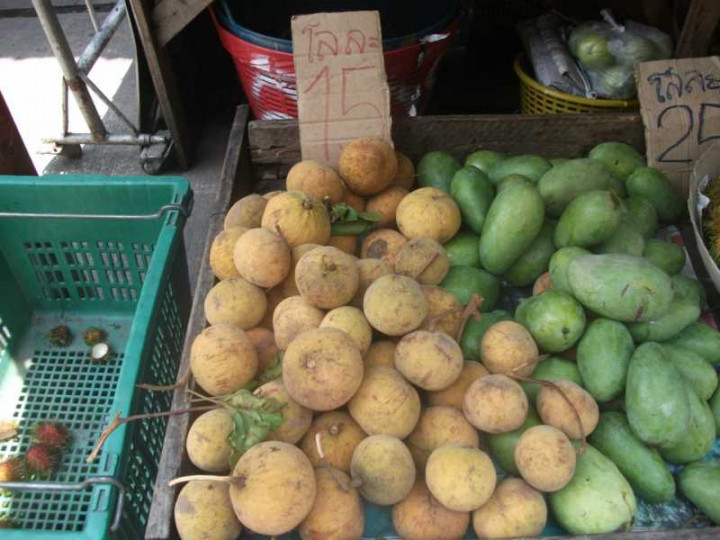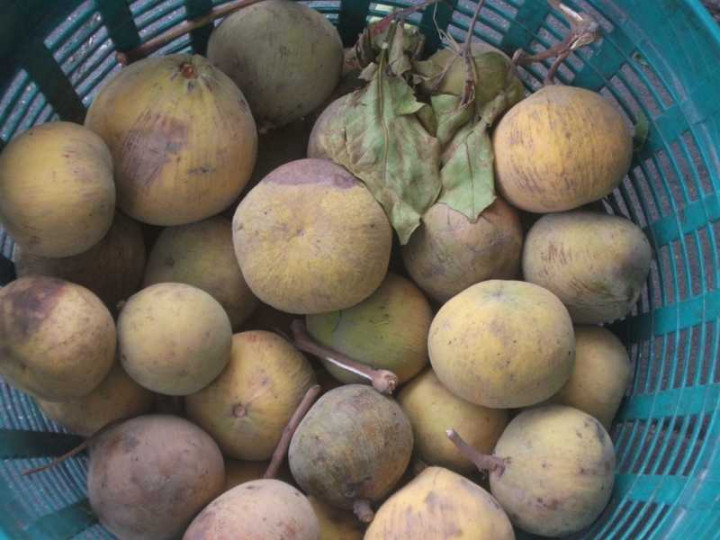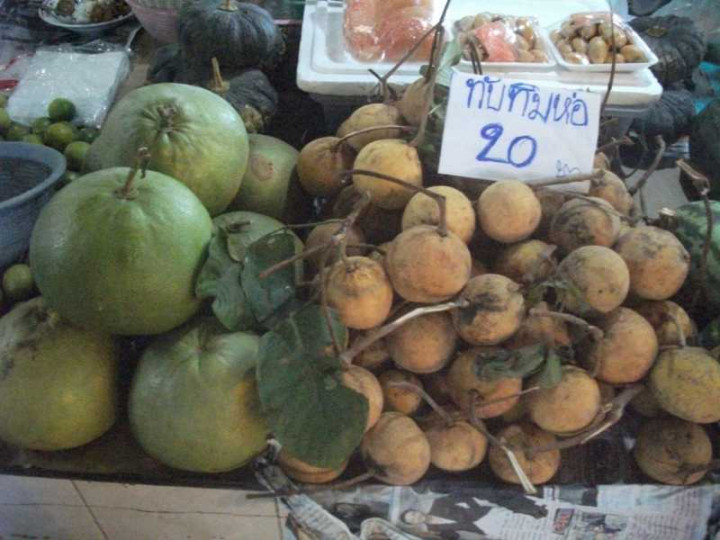| Fruit |
Jan |
Feb |
Mar |
Apr |
May |
Jun |
Jul |
Aug |
Sep |
Oct |
Nov |
Dec |
|---|
 |
BANANA (Gluay)
Three varieties are available; Horm, Nam Wah and Khai. |
Y |
Y |
Y |
Y |
Y |
Y |
Y |
Y |
Y |
Y |
Y |
Y |
 |
CANTALOUPE
Very similar to that in Europe and America, though not as sweet. |
Y |
Y |
Y |
Y |
Y |
Y |
Y |
Y |
Y |
Y |
Y |
Y |
 |
COCONUT (Maprao)
Mature coconuts are used to make coconut cream. Young coconuts are used to make coconut juice. |
Y |
Y |
Y |
Y |
Y |
Y |
Y |
Y |
Y |
Y |
Y |
Y |
 |
CUSTARD APPLE (Noi Naa)
Sweet fruit with many seeds and pale green bumpy outer skin. |
Y |
Y |
|
|
|
|
Y |
Y |
Y |
Y |
Y |
Y |
 |
DURIAN (Turian)
The strong aroma usually prevents visitors from trying this soft, yellow fruit that is eaten by pinching it open. |
Y |
Y |
Y |
Y |
Y |
Y |
Y |
Y |
Y |
Y |
Y |
Y |
 |
GANDARIA or PLUM MANGO (Ma-prang)
A mixture of sweet and sour tastes. The peel can also be eaten. |
|
|
Y |
Y |
Y |
|
|
|
|
|
|
|
 |
GOOSEBERRY (Ma-yom)
Small yellow berries used in desserts and jams. Taste is a bit sour. |
Y |
|
Y |
Y |
Y |
|
|
|
Y |
Y |
|
Y |
 |
GRAPES (A-ngoon)
Purple and white varieties. Both contain seeds. |
Y |
Y |
Y |
Y |
Y |
Y |
Y |
Y |
Y |
Y |
Y |
Y |
 |
GUAVA (Farang)
Thais prefer to eat this while still hard, dipped in sugar and dried pepper. |
Y |
Y |
Y |
Y |
Y |
Y |
Y |
Y |
Y |
Y |
Y |
Y |
 |
JACKFRUIT (Ka-noon)
A sweet yellow fruit covered with a thick skin. Enormous in size. Buy by the 'keed' (100 gm). |
|
|
Y |
Y |
Y |
Y |
Y |
Y |
|
|
Y |
|
 |
JUJUBE (Poodza)
Similar in taste to the apple, this is an oval green fruit known to Thais as the 'Thai Apple'. |
Y |
|
Y |
Y |
|
|
|
|
Y |
Y |
Y |
Y |
 |
LANGSART
A sweet fruit with a pale brown skin that must be carefully peeled with the fingers. An inner stone is quite bitter, so try not to bite it. |
|
Y |
|
|
|
|
|
|
|
|
Y |
|
 |
LITCHEE (Lynchee)
Sweet, juicy fruit inside a hard, red peel. An Asian favorite. |
|
|
|
|
Y |
Y |
|
|
|
|
|
|
 |
LONGAN (Lumyai)
Luscious white fruit with a dark brown skin or shell. Easily peeled and sold in bunches on unpicked branch shoots. |
|
Y |
|
|
|
|
Y |
Y |
Y |
Y |
|
Y |
 |
MANGO (Ma-muang)
A heavenly treat when eaten ripe with sticky rice and coconut cream. For a tart, salty flavor, eat unripened with Thai sauce. |
|
|
Y |
Y |
Y |
Y |
|
|
|
|
|
|
 |
MANGOSTEEN (Mahng-koot)
Dark purple peel with sweet, white fruit inside. Fragrant and aromatic |
Y |
Y |
Y |
Y |
Y |
Y |
Y |
Y |
Y |
Y |
Y |
Y |
 |
ORANGE (Som Cheng)
This variety has a thick, green dessert in a restaurant. |
Y |
Y |
Y |
Y |
Y |
Y |
Y |
Y |
Y |
Y |
Y |
Y |
 |
PAPAYA
Main ingredients of "Sohm-Tumm" a spicy green papaya salad. Ripened fruit should be eaten with fresh lime squeezed on top. |
Y |
Y |
Y |
Y |
Y |
Y |
Y |
Y |
Y |
Y |
Y |
Y |
 |
PINEAPPLE (Sapa-rot)
Mostly from South Thailand. Oddly enough, Chiangrai and Lampang have unique varieties. |
Y |
Y |
Y |
Y |
Y |
Y |
Y |
Y |
Y |
Y |
Y |
Y |
 |
POMELO (Som-oh)
Similar to grapefruit in size and taste, this fruit has a thick peel and is not sour. |
Y |
Y |
Y |
Y |
Y |
Y |
Y |
Y |
Y |
Y |
Y |
Y |
 |
RAMBUTAN (Ngaw)
Juicy with fruit inside a spiky red skin. Easy to pinch open, it's a sweet dessert dish in many of Thailand's restaurants. |
Y |
|
|
|
Y |
Y |
Y |
Y |
Y |
Y |
Y |
Y |
 |
ROSE APPLE (Cham-poo)
Bell-shaped fruit similar to the apple, though not as tart. You'll see it in green or pink. |
Y |
Y |
Y |
Y |
Y |
Y |
|
|
Y |
Y |
|
Y |
 |
SANTOL (Gra-torn)
The yellow flesh of this fruit is usually pickled. The taste is 'salty-sour'. |
Y |
|
|
|
|
Y |
|
|
Y |
Y |
|
Y |
 |
SAPODILLA (La-moot)
An oval shaped fruit with brown peel, it is usually carved before serving. |
|
|
Y |
Y |
Y |
Y |
|
|
|
|
Y |
|
 |
STAR APPLE (Ma-feung)
A tart yellow fruit when ripe. Star-shaped when cross cut. |
|
|
|
|
|
|
|
|
|
|
|
|
 |
STRAWBERRY
This well-known fruit is now found almost everywhere. December and January are the best months in Chiangmai. |
Y |
Y |
|
|
|
|
|
|
|
|
|
Y |
 |
WATERMELON (Tang-mo)
Same great flavor as at home, red or yellow. |
Y |
Y |
Y |
Y |
Y |
Y |
Y |
Y |
Y |
Y |
Y |
Y |



































